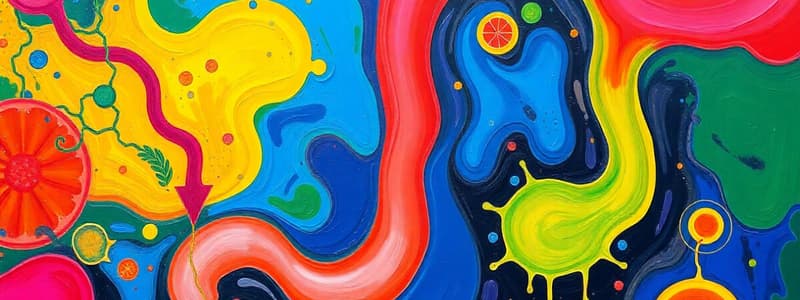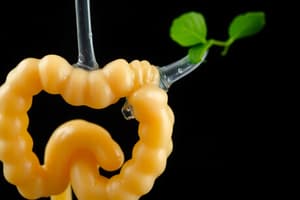Podcast
Questions and Answers
Which enzyme initiates the breakdown of carbohydrates in the digestive process?
Which enzyme initiates the breakdown of carbohydrates in the digestive process?
- Salivary Amylase (correct)
- Salivary Lipase
- Trypsin
- Pepsin
What is the term for the mixture of chewed food and saliva as it travels from the mouth?
What is the term for the mixture of chewed food and saliva as it travels from the mouth?
- Bolus (correct)
- Feces
- Bile
- Chyme
Which of the following is NOT a component of gastric secretions important for digestion?
Which of the following is NOT a component of gastric secretions important for digestion?
- Hydrochloric Acid (HCl)
- Pepsin
- Gastric Lipase
- Pancreatic Amylase (correct)
What is the primary role of bile in digestion?
What is the primary role of bile in digestion?
Which part of the small intestine directly receives chyme from the stomach?
Which part of the small intestine directly receives chyme from the stomach?
The inner lining of the small intestine contains finger-like projections called:
The inner lining of the small intestine contains finger-like projections called:
Which of the following is NOT a section of the large intestine?
Which of the following is NOT a section of the large intestine?
Which of the following enzymes is responsible for protein digestion in the small intestine?
Which of the following enzymes is responsible for protein digestion in the small intestine?
What is the primary function of the lower esophageal sphincter?
What is the primary function of the lower esophageal sphincter?
Where does the initial breakdown of fats begin in the digestive tract?
Where does the initial breakdown of fats begin in the digestive tract?
What is the role of enterocytes in the small intestine?
What is the role of enterocytes in the small intestine?
How are fats primarily transported after absorption in the small intestine?
How are fats primarily transported after absorption in the small intestine?
What is the function of the pyloric sphincter?
What is the function of the pyloric sphincter?
Which of these is NOT directly involved in the digestion of proteins?
Which of these is NOT directly involved in the digestion of proteins?
What is the function of microvilli in the digestive system?
What is the function of microvilli in the digestive system?
Which of the following accurately represents the sequence of segments food goes through in the small intestine?
Which of the following accurately represents the sequence of segments food goes through in the small intestine?
Which substance emulsifies fats in the duodenum?
Which substance emulsifies fats in the duodenum?
Which process primarily occurs in the large intestine?
Which process primarily occurs in the large intestine?
Flashcards
Digestion
Digestion
The process of breaking down food into smaller molecules that can be absorbed by the body.
Macronutrients
Macronutrients
Large molecules in food that provide energy and building blocks for the body.
Micronutrients
Micronutrients
Smaller molecules in food that are essential for various bodily functions.
Salivary Amylase
Salivary Amylase
Signup and view all the flashcards
Esophagus
Esophagus
Signup and view all the flashcards
Stomach
Stomach
Signup and view all the flashcards
Chyme
Chyme
Signup and view all the flashcards
Villi
Villi
Signup and view all the flashcards
Digestive Tract
Digestive Tract
Signup and view all the flashcards
Bolus
Bolus
Signup and view all the flashcards
Lower Esophageal Sphincter
Lower Esophageal Sphincter
Signup and view all the flashcards
Stomach Churning
Stomach Churning
Signup and view all the flashcards
Hydrochloric Acid (HCl)
Hydrochloric Acid (HCl)
Signup and view all the flashcards
Duodenum
Duodenum
Signup and view all the flashcards
Bile
Bile
Signup and view all the flashcards
Central Lacteal
Central Lacteal
Signup and view all the flashcards
Study Notes
Digestion Basics
- Digestion breaks down food into absorbable units.
- Macronutrients are carbohydrates, fats, and proteins.
- Micronutrients are vitamins and minerals.
- The digestive tract is a long tube from mouth to anus.
Salivary Enzymes
- Saliva contains amylase (carbohydrate digestion) and lipase (fat digestion).
- Salivary amylase initiates carbohydrate digestion.
- Salivary lipase starts fat digestion.
- Chewed food mixed with saliva forms a bolus.
- Salivary glands secrete saliva.
Esophagus and Stomach
- The bolus moves from the esophagus to the stomach.
- The lower esophageal sphincter controls stomach entry.
- A leaky lower esophageal sphincter can cause heartburn.
- Stomach secretions include:
- Hydrochloric acid (HCl)
- Pepsin (protein digestion)
- Gastric Lipase (continues fat digestion).
- The stomach churns food, creating chyme.
- Chyme is the liquid mixture of food that leaves the stomach.
Small Intestine
- Chyme passes from the stomach to the duodenum via the pyloric sphincter.
- The pyloric sphincter controls chyme release from the stomach into the small intestine.
- Bile, produced in the liver and stored in the gallbladder, aids fat digestion.
- Bile emulsifies fats in the duodenum.
- The pancreas releases enzymes into the duodenum:
- Pancreatic amylase (continues carbohydrate digestion)
- Pancreatic lipase (continues fat digestion)
- Trypsin (protein digestion)
- Chymotrypsin (protein digestion)
- The ~15-30 foot small intestine breaks down food into absorbable units.
- The small intestine is a long, coiled tube, where food is broken down and absorbed.
- Parts of the small intestine: duodenum, jejunum, ileum.
Large Intestine
- The small intestine connects to the large intestine via the ileocecal valve.
- The large intestine absorbs water and some solutes.
- Feces are stored and dried in the large intestine.
- Parts of the large intestine: ascending, transverse, descending, sigmoid colon.
- Feces are formed and expelled through the anus.
Villus Structure
- The small intestine's inner lining has villi (finger-like projections) increasing surface area for absorption.
- Microvilli further increase surface area, forming the brush border.
- Enterocytes (cells in the brush border) facilitate nutrient absorption.
- Villi are finger-like projections in the small intestine that increase surface area for absorption.
- Microvilli are hair-like projections on villi, further increasing surface area.
- Enterocytes are cells that make up the microvilli and aid in nutrient absorption
Nutrient Absorption
- Fats are absorbed into the central lacteal within each villus, entering the lymphatic system.
- Proteins and carbohydrates are absorbed directly into the bloodstream via surrounding capillaries.
- The central lacteal is a lymphatic vessel within each villus.
- Fats are absorbed into the central lacteal and transported through the lymphatic system.
- Blood capillaries surround each villus.
- Proteins and carbohydrates are absorbed into the bloodstream.
Appendix
- The appendix, a small pouch near the cecum, can become inflamed (appendicitis) if blocked.
- The appendix is a small pouch at the beginning of the large intestine.
Additional Notes
- Digestion begins in the mouth with chewing.
- Saliva contains enzymes that begin the digestion of carbohydrates and fats.
- Chewed food is swallowed as a bolus.
- The bolus passes down the esophagus.
- The esophagus connects the mouth to the stomach.
Studying That Suits You
Use AI to generate personalized quizzes and flashcards to suit your learning preferences.
Description
Explore the fundamentals of digestion, starting from the mouth to the stomach. Learn about macro and micro nutrients, the role of saliva and enzymes like amylase and lipase, and how food travels through the digestive tract. This quiz delves into the functions and processes essential for breaking down food.




